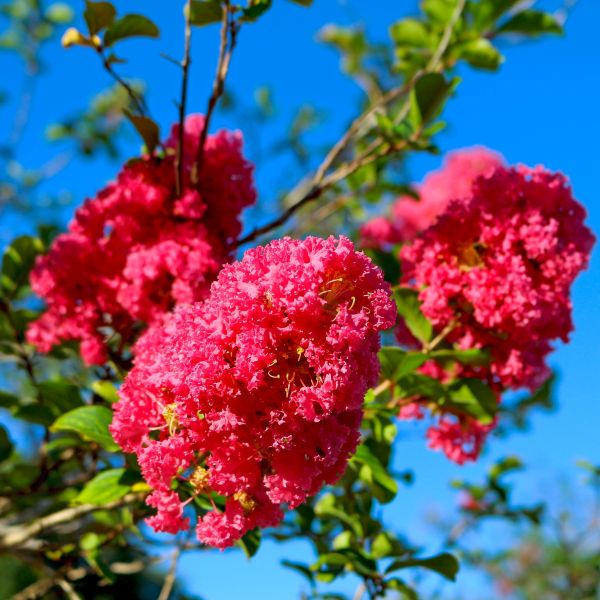
Pink Crape Myrtle
Lagerstroemia indica pink selection
88 reviews
Pink Crape Myrtle
Lagerstroemia indica pink selection
88 reviews
2.5 Gallon Shrub Form
We are sorry, product is currently out of stock due to seasonal availability. Please check the "Related plants available in your area" section below
Not just beautiful - intentionally selected by ShrubHub's 3D landscape design team to fit real-world spaces and maximize yard potential.
Why Pink Crape Myrtle?
Pink Crape Myrtle (Lagerstroemia indica pink selection) is a popular choice for its stunning pink flowers and vibrant summer blooms. This variety offers a touch of elegance and grace to any landscape, with its compact size making it suitable for gardens of all sizes. Additionally, it is a low-maintenance plant that requires minimal care, making it an ideal choice for both beginner and experienced gardeners.
Sunlight
Pink Crape Myrtle requires full sun exposure to grow and bloom successfully.
Watering
Pink Crape Myrtle requires regular watering, especially during dry periods. It prefers moist, well-drained soil, but be careful not to overwater as this can lead to root rot. Aim to provide around 1 inch of water per week.
Fertilizing
The Pink Crape Myrtle typically requires a balanced fertilizer with equal parts nitrogen (N), phosphorus (P), and potassium (K). It is recommended to fertilize the plant once in early spring and again in mid-summer.
Pink Crape Myrtle (Lagerstroemia indica pink selection)
The Pink Crape Myrtle, scientifically known as Lagerstroemia indica pink selection, is a beautiful flowering tree that adds a touch of elegance and color to any landscape. It is a deciduous tree that belongs to the Lythraceae family and is native to Asia.
Key Features:
- Height: The Pink Crape Myrtle typically grows to a height of 10-20 feet, making it an ideal choice for smaller gardens or yards.
- Flowering: This variety of Crape Myrtle is known for its stunning pink flowers that bloom profusely during the summer months. The vibrant pink blossoms form clusters at the end of its branches, creating a beautiful canopy of color.
- Foliage: The tree has attractive dark green leaves that turn a stunning orange-red color in the fall, providing a spectacular display of autumn colors.
- Hardiness: Pink Crape Myrtle is a hardy tree that can withstand various climatic conditions, including heat and humidity. It is also known for its resistance to diseases and pests.
- Growth Habit: This selection of Lagerstroemia indica has a spreading growth habit with a rounded crown, creating a graceful and symmetrical form.
- Adaptability: It thrives in full sun to partial shade, making it versatile for different lighting conditions. It prefers well-drained soil but can tolerate a variety of soil types.
- Landscape Use: Pink Crape Myrtles are widely used in landscaping to add color and beauty to gardens, parks, streetscapes, and other outdoor spaces. They can be planted as specimen trees or in groups to create a stunning visual impact.
Care Instructions:
Proper care and maintenance are essential to ensure the healthy growth and longevity of the Pink Crape Myrtle:
- Watering: Regular watering, especially during the first year after planting, is important to establish a strong root system. Once established, the tree is relatively drought-tolerant.
- Pruning: Prune in late winter or early spring to remove dead or weak branches and promote vigorous growth. Pruning can also be done to shape the tree or control its size.
- Fertilization: Apply a slow-release balanced fertilizer in spring to encourage healthy growth and abundant flowering. Follow the recommended dosage on the fertilizer package.
- Pest and Disease Control: Pink Crape Myrtles are generally resistant to pests and diseases. However, regular inspection for common problems such as aphids or powdery mildew is advisable. Treat any issues promptly using appropriate insecticides or fungicides if necessary.
- Winter Care: In colder regions, protect the tree during winter by mulching around the base and covering it with a protective barrier to shield it from freezing temperatures.
With its eye-catching pink flowers, attractive foliage, and easy maintenance, the Pink Crape Myrtle is a perfect choice for those seeking a stunning flowering tree that will bring life and color to their landscape.
Plant Information:
| Botanical Name: | Lagerstroemia indica pink selection |
| USDA Zones: | 6 - 10 |
| Water: | Moderate - Low Once Established |
| Exposure: | Full Sun |
| Soil Needs: | Well-Drained |
| Mature Height: | 10 - 20 feet |
| Mature Spread: | 6 - 8 feet |






Pollination Info
Pollination Info for Pink Crape Myrtle (Lagerstroemia indica Pink Selection)
- Pollination Type: Self-pollinating
- Pollinators: Bees, butterflies, and other insects
- Blooming Season: Summer to fall
- Bloom Color: Pink
- Pollination Requirements:
Pink Crape Myrtle, or Lagerstroemia indica Pink Selection, is a self-pollinating variety. This means that it can produce viable seeds and set fruits without the need for cross-pollination with another crape myrtle tree.
However, despite being able to self-pollinate, Pink Crape Myrtle greatly benefits from visits by pollinators such as bees, butterflies, and other insects. These pollinators transfer pollen from the stamens (male reproductive organs) to the pistil (female reproductive organ) of the flowers, aiding in fertilization and seed production.
The blooming season of Pink Crape Myrtle usually occurs from summer to fall. During this time, the tree displays abundant clusters of pink flowers that attract pollinators. These vibrant blooms not only enhance the aesthetic appeal of the tree but also serve as a food source for bees and butterflies.
To ensure optimal pollination and fruit set, it is beneficial to create a pollinator-friendly garden environment around your Pink Crape Myrtle. This can be achieved by planting nectar-rich flowers nearby and avoiding the use of pesticides that might harm pollinators.
FAQ
Pink Crape Myrtle (Lagerstroemia indica pink selection) FAQs
1. What is a Pink Crape Myrtle?
A Pink Crape Myrtle (Lagerstroemia indica pink selection) is a flowering tree known for its showy clusters of pink flowers during the summer months. It belongs to the Lagerstroemia indica species, and the pink selection refers to a specific variety within that species that produces pink blooms.
2. How tall does a Pink Crape Myrtle grow?
Pink Crape Myrtles can grow up to 20-30 feet in height, depending on the specific variety and growing conditions. Some cultivars may stay more compact, while others can reach taller heights.
3. When does a Pink Crape Myrtle bloom?
Pink Crape Myrtles typically bloom in the summer, usually from late spring to early fall. The exact timing may vary depending on the climate and location.
4. How much sun does a Pink Crape Myrtle need?
Pink Crape Myrtles thrive in full sun, meaning they require at least 6-8 hours of direct sunlight daily to grow and bloom properly. They may not perform well in shady locations.
5. How do I care for a Pink Crape Myrtle?
Here are some general care guidelines for Pink Crape Myrtles:
- Watering: Provide regular watering, especially during the first year after planting to establish a strong root system. Once established, they are somewhat drought-tolerant.
- Pruning: Prune in late winter or early spring before new growth emerges. Remove dead or weak branches and shape the tree as desired.
- Fertilization: Apply a balanced slow-release fertilizer in early spring to promote healthy growth and blooming. Follow the manufacturer's instructions.
- Mulching: Apply a layer of mulch around the base of the tree to conserve moisture, suppress weeds, and protect the roots.
- Pest and Disease Control: Monitor for common pests like aphids or powdery mildew. Treat with appropriate insecticides or fungicides if necessary.
6. Can I grow a Pink Crape Myrtle in a container?
While Pink Crape Myrtles are typically grown as landscape trees, some dwarf varieties can be suitable for container gardening. Choose a compact cultivar and use a large enough container with proper drainage. Regular watering and fertilization may be required for potted plants.
7. Is the Pink Crape Myrtle deer-resistant?
Pink Crape Myrtles are known to be deer-resistant, meaning they are less likely to be browsed by deer compared to some other plants. However, keep in mind that hungry deer may still nibble on the foliage during times of food scarcity.
8. Can I propagate a Pink Crape Myrtle?
Yes, Pink Crape Myrtles can be propagated through various methods including cuttings, layering, or by collecting and planting seeds. However, keep in mind that the resulting plants may not retain the exact characteristics of the parent plant, especially in terms of flower color.
Planting & Care
Planting and Care for Pink Crape Myrtle (Lagerstroemia indica pink selection)
Planting:
- Choose a site with full sun exposure for optimal growth and flowering.
- Ensure the soil is well-drained. Pink Crape Myrtles prefer slightly acidic soil, but they can tolerate a wide range of soil types.
- Dig a hole that is twice as wide and just as deep as the root ball of the plant.
- Place the plant in the hole, ensuring that the top of the root ball is level with or slightly above the surrounding soil.
- Backfill the hole with soil, gently firming it around the root ball to eliminate any air pockets.
- Water the newly planted Pink Crape Myrtle thoroughly to settle the soil.
Care:
- Watering:
- Keep the soil consistently moist but not waterlogged during the first year after planting.
- Established Pink Crape Myrtles are drought-tolerant and require watering only during prolonged dry periods.
- Fertilizing:
- Apply a balanced, slow-release fertilizer in early spring before new growth appears.
- Follow the manufacturer's instructions for recommended dosage.
- Do not fertilize after mid-summer to avoid encouraging late-season growth that may be vulnerable to winter damage.
- Pruning:
- Prune Pink Crape Myrtles in late winter or early spring before new growth emerges.
- Remove any dead or damaged branches.
- Thin out overcrowded branches to improve air circulation and promote better flowering.
- Do not excessively trim or "top" the plant, as this can lead to weak growth and fewer blooms.
- Winter Care:
- Pink Crape Myrtles are generally hardy and do not require special winter protection in most regions.
- In colder climates, you can apply a layer of mulch around the base of the plant to help insulate the roots from freezing temperatures.
With proper planting and care, your Pink Crape Myrtle will reward you with prolific pink blooms and a beautiful addition to your garden.
Check Out These Verified Customer Reviews:
Customer Reviews
4.7 out of 5 based on 88 reviews
Thank you! Your review has been submitted.
I received excellent customer service when I had a question about caring for my Pink Crape Myrtle.
The quality of the Pink Crape Myrtle is top-notch. It's a gorgeous addition to my garden.
I ordered the Pink Crape Myrtle online and the website was easy to navigate. The plant was well-packaged and arrived in good condition. Overall, a great purchase!
Item has been added to your cart.


